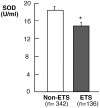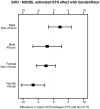Detrimental effects of environmental tobacco smoke in relation to asthma severity
- PMID: 21572527
- PMCID: PMC3087715
- DOI: 10.1371/journal.pone.0018574
Detrimental effects of environmental tobacco smoke in relation to asthma severity
Abstract
Background: Environmental tobacco smoke (ETS) has adverse effects on the health of asthmatics, however the harmful consequences of ETS in relation to asthma severity are unknown.
Methods: In a multicenter study of severe asthma, we assessed the impact of ETS exposure on morbidity, health care utilization and lung functions; and activity of systemic superoxide dismutase (SOD), a potential oxidative target of ETS that is negatively associated with asthma severity.
Findings: From 2002-2006, 654 asthmatics (non-severe 366, severe 288) were enrolled, among whom 109 non-severe and 67 severe asthmatics were routinely exposed to ETS as ascertained by history and validated by urine cotinine levels. ETS-exposure was associated with lower quality of life scores; greater rescue inhaler use; lower lung function; greater bronchodilator responsiveness; and greater risk for emergency room visits, hospitalization and intensive care unit admission. ETS-exposure was associated with lower levels of serum SOD activity, particularly in asthmatic women of African heritage.
Interpretation: ETS-exposure of asthmatic individuals is associated with worse lung function, higher acuity of exacerbations, more health care utilization, and greater bronchial hyperreactivity. The association of diminished systemic SOD activity to ETS exposure provides for the first time a specific oxidant mechanism by which ETS may adversely affect patients with asthma.
Conflict of interest statement
Figures


References
-
- Jarjour NN, Busse WW, Calhoun WJ. Enhanced production of oxygen radicals in nocturnal asthma. Am Rev Respir Dis. 1992;146:905–911. - PubMed
-
- Gaston B, Drazen JM, Loscalzo J, Stamler JS. The biology of nitrogen oxides in the airways. Am J Respir Crit Care Med. 1994;149:538–551. - PubMed
-
- MacPherson JC, Comhair SA, Erzurum SC, Klein DF, Lipscomb MF, et al. Eosinophils are a major source of nitric oxide-derived oxidants in severe asthma: characterization of pathways available to eosinophils for generating reactive nitrogen species. J Immunol. 2001;166:5763–5772. - PubMed
Publication types
MeSH terms
Substances
Grants and funding
- HL091762/HL/NHLBI NIH HHS/United States
- HL69170/HL/NHLBI NIH HHS/United States
- R01 HL069116/HL/NHLBI NIH HHS/United States
- HL069167/HL/NHLBI NIH HHS/United States
- P01 HL081064/HL/NHLBI NIH HHS/United States
- UL1 RR024992/RR/NCRR NIH HHS/United States
- HL081064/HL/NHLBI NIH HHS/United States
- UL1 TR000454/TR/NCATS NIH HHS/United States
- RR024992/RR/NCRR NIH HHS/United States
- HL069174/HL/NHLBI NIH HHS/United States
- R01 HL069167/HL/NHLBI NIH HHS/United States
- HL69174/HL/NHLBI NIH HHS/United States
- UL1 RR024989/RR/NCRR NIH HHS/United States
- R01 HL091762/HL/NHLBI NIH HHS/United States
- UL1 TR000005/TR/NCATS NIH HHS/United States
- R01 HL069155/HL/NHLBI NIH HHS/United States
- HL69116/HL/NHLBI NIH HHS/United States
- R01 HL069174/HL/NHLBI NIH HHS/United States
- M01 RR003186/RR/NCRR NIH HHS/United States
- 1UL1RR024989/RR/NCRR NIH HHS/United States
- R01 HL069170/HL/NHLBI NIH HHS/United States
- RR03186/RR/NCRR NIH HHS/United States
- HL69155/HL/NHLBI NIH HHS/United States
- U10 HL109250/HL/NHLBI NIH HHS/United States
- UL1 RR025011/RR/NCRR NIH HHS/United States
- P01 HL103453/HL/NHLBI NIH HHS/United States
- 1UL1RR025011/RR/NCRR NIH HHS/United States
- U10 HL109164/HL/NHLBI NIH HHS/United States
- UL1 TR000448/TR/NCATS NIH HHS/United States

